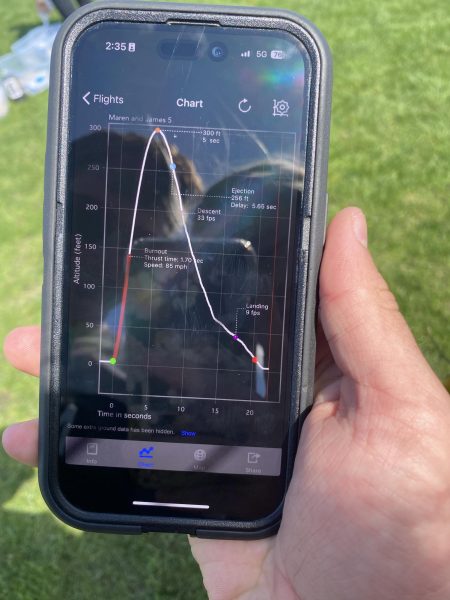Sophomores Maren Overgaard and James Welsh broke the long-standing rocket project record by being the first Aerospace engineering students to have launched their rockets exactly 300 feet in the air.
The rocket project has always been a highly anticipated unit in SPA’s Advanced Aerospace Engineering course. The project parameters include a weight limit of 400 grams and a height goal of exactly 300 feet straight up.
“You have to be more intentional with your rocket design. [You’re not] gonna just build a rocket and launch it 5,000 feet in the air,” Overgaard said.
Since the end of spring break, the class has done some research into the mechanics of rockets by running a few tests on different kinds of engines and fins to get a basic understanding before designing.
You’re like setting off a bomb on school property, which is pretty cool.
— Maren Overgaard
After researching, students jumped straight into the designing phase of the engineering process, using software called RocketSim10 to run flight simulations. Every group had a budget of $60, and they purchased different materials and premade components from Hub Hobby, a store that carries compatible model rocket parts, to construct their rockets. Students then utilized the large variety of preset materials in RocketSim to build and simulate a launch. Welsh said, “[Our] body was I think coated cardboard. [Our] fins were wood…we laser cut those.”
Another budget constraint was the Simple Digital System (SDS) model rocket engines every group had to use. The engines were only one-time-use, so people could only test as many times as they had the budget to buy engines. “If you only buy four engines, you only get to launch four times,” Overgaard said.

Photo submitted by Maren Overgaard.
Students also invested their $60 into Parachutes, another essential component besides building materials. Ensuring your rocket has a light landing during test launches saves students from having to fix or rebuild parts of their rocket before the final launch.
“You could design your own parachute, but most people chose to invest in a higher quality parachute because you only get one rocket. You want your rocket to survive each flight,” Overgaard said.
Overgaard and Welsh used trial and error to improve their rocket, collecting data on what did and didn’t work after every test. Welsh said, “[After looking at our flight path,] we added weight and sometimes took it away depending on how the rocket was performing.”
It started off pretty rough. We started at 169 feet and then we kept going up …169, 205, 265, 296, and then 300 [feet] on the last day.
— James Welsh
For each test run Overgaard and Welsh ran, their flight height steadily got closer and closer to their 300-foot goal. “It started off pretty rough. We started at 169 feet and then we kept going up …169, 205, 265, 296, and then 300 [feet] on the last day,” Welsh said.
Overgaard’s favorite part of the project was finally testing the rockets and witnessing how all her classmates’ efforts came to fruition in spectacular take-offs. “[When launching the rockets] you’re like setting off a bomb on school property, which is pretty cool,” Overgaard said.
The project spanned around a month and their final launch was on May 1.